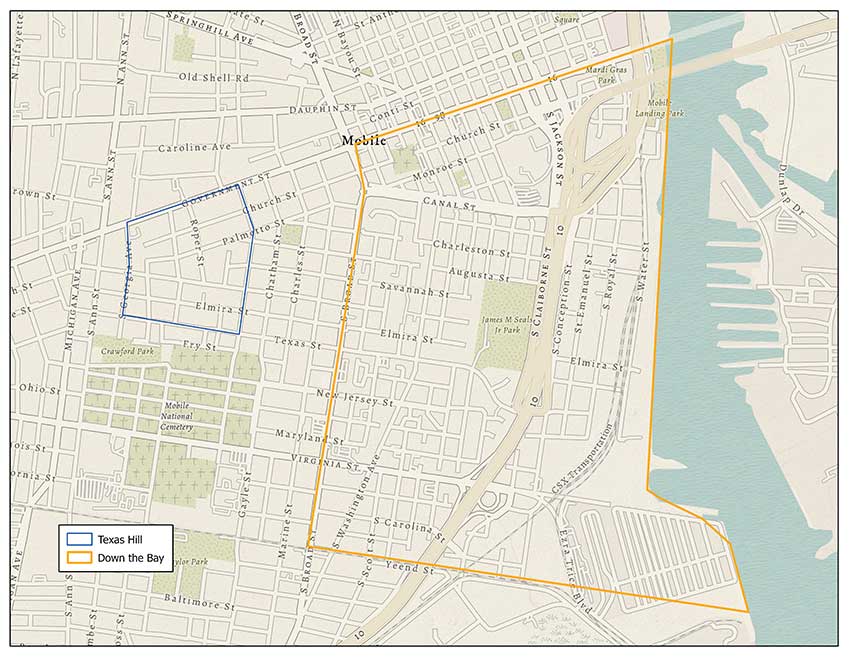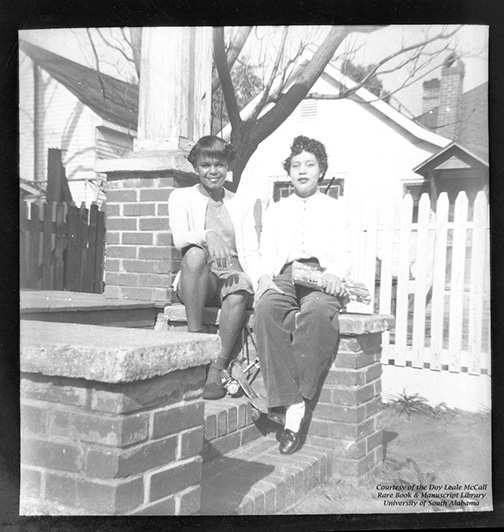Mapping Memory: Texas Hill
Posted on October 24, 2023 by Candice Fairchild
The remarkable thing about oral history, in all of its sonic richness, is the ability of a community to construct a nuanced and vivid sense of place, creating a marriage of image and sound allowing their audience to both hear and see a place. A single physical location, a grocery store, a church, a street, take on life through cinematic snapshots of recollection. Memory cultivates a history buzzing with the vibrancy of generations. This blog post will be the first in a series entitled, “Mapping Memory.” This series of posts will focus on the Down the Bay Oral History Project’s efforts to document the Down the Bay community in the voices of those who have lived there and directly engaged with the area.
A prime example of the miraculous power of voiced experience is the legacy of Texas Hill. Elmira Street, located in the neighborhood dubbed Texas Hill, was a hub for congregating children. What seems like an ordinary road becomes a mosaic of children’s laughter as several interviewees describe a shared experience roller skating down Texas Hill during the Christmas season. Texas Hill is a site of tradition.
A choir of voices paint the image of Texas Hill. Leila Roberts Reed recalls how Texas Street became Texas Hill:
Leila Roberts Reed
We didn’t really go to Texas Hill. They call it Texas Hill. The reason why they call it Texas Hill, there was a hill where we used to skate down. You had the roller skates, and we used to skate, pop the whip, and all of that. And that’s why—we didn’t call it Texas Street, we called it Texas Hill.

The location of the Texas Hill neighborhood (as described by Clarence Lott Jr. in an interview with Dr. Kern Jackson in 1999) in juxtaposition to the rest of the Down the Bay area (as roughly described in oral history interviews).
While Wilbur Coleman Nesbitt describes the excitement of Christmas,
While Wilbur Coleman Nesbitt
Christmas Day was a real family day. Most of the gifts we got were pajamas, slippers; you might get a pair of—they called them “dungarees” then, and a shirt. But roller skates. And on Christmas Day—this was when we were younger—we just stayed on Elmira Street. Everybody skated. But as my brothers got older, they went to Selma Street. And Selma Street was filled with kids, skating from Selma all the way up to Texas Hill. And everybody came across Broad Street, 500 of them at a time, you know. But it was just—everybody had roller skates, and peppermint sticks that you stuck in an orange, you know?

This glass skate was recovered from RV City during the I-10 Mobile River Bridge Archaeology Project.
Violetta Simpson describes the certainty of tradition:
Violetta Simpson
It didn’t make any difference how much money your parents had, or how much money your parents didn’t have; everybody got skates, pair of jeans, and a flannel shirt. Okay? And you would go skating. Oh, you’d get a bag, and in the bag it would be like an apple and an orange and some peppermint, you know, that kind of little thing. And it would be tied with a little bow and what have you. And we’d all get together and go skating on Texas Hill. Well, Texas Hill was actually—is actually—a hill. So, you’d go up that and you’d go skating. And I mean, it would be kids from all over; the whole Down the Bay. Maybe 200 kids up there trying to skate down the hill, on Texas Hill.

These two young women have a pair of skates in tow. They may have been coming from or preparing to go on a venture to Texas Hill. Courtesy of the Ernest Horton Collection, Doy Leale McCall Rare Book and Manuscript Library, University of South Alabama.
I imagine that if I could stand at the foot of Texas Hill today, I’d see flashes of flannel clad children smiling, playing “pop the whip,” and racing down the hill. I imagine I’d smell the scent of peppermint and orange fill the air. I imagine I’d hear their laughs, exuberant chortles and squeals of delight as they gain momentum, wheels gliding across the ground in the rushing cacophony of a generation’s glee. Persisting past the changes of urban renewal and the demands of development, the voices of Down the Bay sustain their community. Texas Hill is alive and well, flourishing in the spoken memories of those who have loved it and lived it.
Written By: Candice Fairchild
Candice Fairchild is a second-year Ph.D. student in English at the University of Alabama. Candice has worked as a transcriber for the Down the Bay Oral History Project and finds inspiration for her blog posts from her experience listening to and transcribing those interviews.
Check out her other posts about the project:
Mapping Memory: Harlem Theater
Feeding the Community: Narrative Sustenance and Down the Bay


